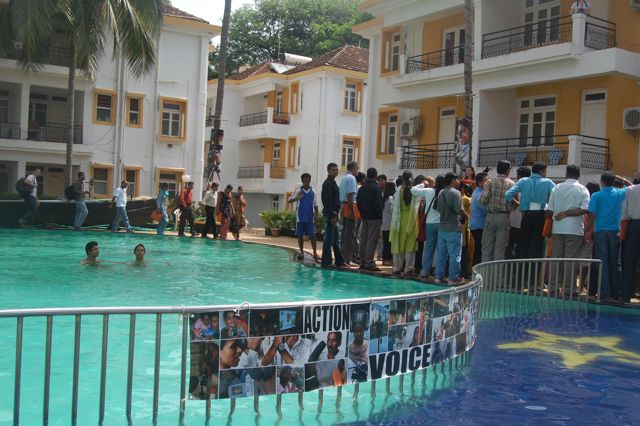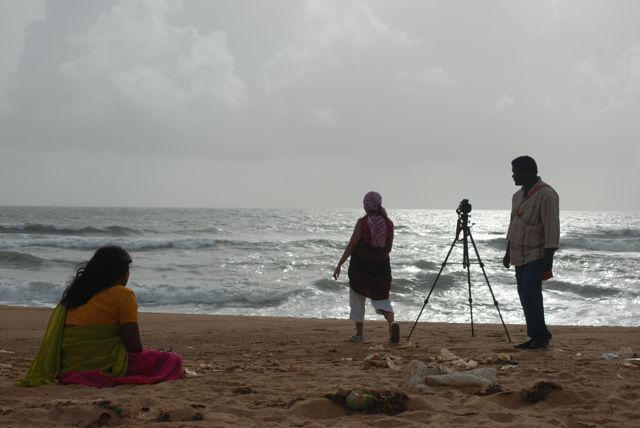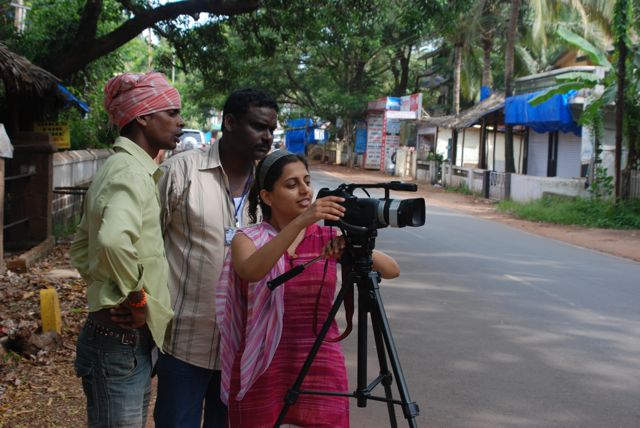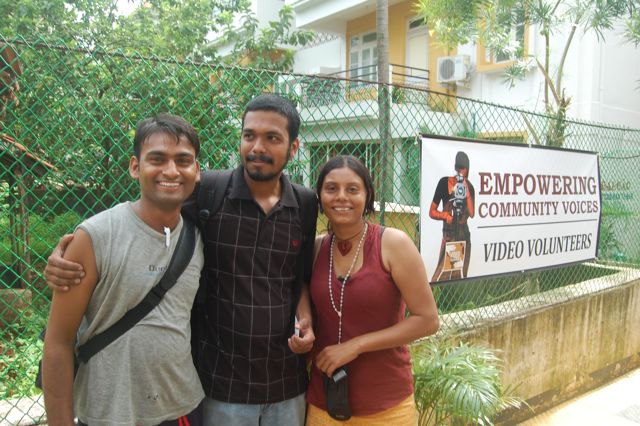
"You mean to say that sending the email is free?! I don't have to pay for it?"
Laxmi was amazed that there is no equivalent on the Internet to paying for a postage stamp to send a letter. The first twenty minutes of this workshop on digi-activism being held in Goa, India were over her head, but when she saw her own language, Telugu, appear on the Google.co.in search page, she jumped to attention. For the first time, Laxmi is seeing something on the Internet that she can actually read. She smiles and begins chattering away in her own language as she reads through the search results for "human rights" on the Google Telugu page.
Laxmi is a community producer with a community video unit in Andhra Pradesh called Manyam Praja Video. All of its producers are so-called "tribals," meaning they are members of India's indigenous communities that live mostly in the remote mountainous parts of the country. Laxmi was one of 130 participants at Video Volunteers' (VV) 5-day Community Video Training Camp held at a resort in Goa from August 11 to 14. Roughly half of the participants were VV's community video producers. Other participants included college students studying journalism and communications and workers in NGOs.
Participants signed up for different workshops on topics including music videos, creative camera work, digi-activism, silent film, video blogging and animation. Each morning and evening featured presentations by different community media groups and media activists, and the last two days featured panel discussions with academics and NGO leaders.
When Mary Joyce, an workshop instructor and the founder of digiactive.org., was observing Laxmi, she understood her challenge for the rest of the workshop -- to balance the amazing skills and experience she can share from her days working for the Obama campaign's new media department with the needs of some participants who were seeing the Internet for the first time in their lives.
In the next room next to her, instructors Kamayani Bali and Freeman Murray were projecting videos made by the community video producers in attendance. The producers were amazed when they saw their work on YouTube.
"12,000 people watched our video! Youth can change things!" one said.
"Can you translate the comments?" asked another.
The instructors obliged and translated the comments. "This is democracy in action," read one comment. "Media that is of, for and by the people."
Another person commented that "You, Samta [the producer] are a hero to young girls. You give a voice to those who aren't heard."
A video about the demolition of slum houses sparked a typical Internet rant about the "filthy people in the slums," and some of the producers who live in those slums were introduced to the whole concept of freedom of speech on the web.
For the past two years, VV had been bringing our community video producers together for joint training workshops. This year, we wanted to widen the group of participants to include NGOs and students who'd expressed interest in community media, or were carrying out successful projects of their own. We'd talked about the idea of community video as a movement, and we wanted to test out that concept. The response was overwhelming: more than 250 people applied for only 130 seats. We had applications from roughly 55 NGOs from all over India, all of whom want to get into community video.
Below is a brief rundown of what happened.
Workshops
All participants were assigned to different tracks such as music videos, creative camera work, digi-activism, video blogging, silent film and animation. Each of these workshops was led by an outside facilitator, such as well-known documentary filmmaker Paromita Vohra and Bollywood director Arjun Bali.
These tracks were all areas that producers had previously asked to learn about. Freed from their usual pressures of making work with a focus on social change, these workshops on "fun" subjects like animation and music videos stimulated their creativity in fantastic ways. In each workshop, the participants made 3 to 4 videos that were later screened on the last night of the workshop. Many of the videos were funny and clearly inspired by Bollywood. They also had a strong romantic subtext. Watching all 20 videos together on the final night gave everyone a tremendous sense of accomplishment.
The videoblogging workshop had producers create a video blog where each week they would select one online video that relates to a specific theme. The exercise was simply to search YouTube for videos of water, for example, and select the one they liked best. But for people who were seeing the Internet for the first time, this process opened up their minds to new possibilities. One learning I took away from the workshop is that we must get the community video units online because it can help them conduct independent research and learning.
For those of us at Video Volunteers who have put so much emphasis on developing the critical thinking skills of the community producers, it was really important to see what a shared learning environment would be like. The mixing of groups turned out really well. The NGO workers became convinced of the potential of community video when they worked side by side with such articulate, empowered individuals.
The producers, some of whom had had traveled on a train for the first time in their lives to attend the workshop, had a chance to make videos with people who had a high level of expertise and life experience.
As for the college students? Well, the typical response was, "I've studied film for three years, and I've seen hundreds more films than they have, yet these community producers know so much more than me."
Another response I heard was, "When I saw their videos, all my stereotypes went away. I had no idea they would be making films better than our own student projects."
Another volunteer expressed it quite simply: "I'm humbled."
For the producers, the positive feedback they received was immensely motivating and confidence-building. The conversations that took place around the poolside bar each evening between the community producers and the highly experienced facilitators gave everyone a sense of being valued professionals.
This was only a small experiment. But it certainly made me feel that universities and schools could successfully put students with formal and informal education in the same classrooms.
Panels
The two days of panels started off with producers from each community video unit telling "impact stories." Neeru, a young Dalit producer from Gujarat, recounted what had happened to her a few weeks back.
She was making a film about migration that described how people need to leave the villages for work. The "call to action" of the film was that people should access the government's program that guarantees 100 days of employment to all rural unemployed, as this is a way to stem migration. On her own accord, Neeru led a rally of villagers to her local government employment office. Three hundred people joined her in the rally and demanded work. The government officials tried to push her -- and especially her camera -- out of the office, but they persevered.
The next day, all 300 people were given work assignments. It was apparent through Neeru's breathless retelling of the story, which included details about her background and childhood, that she feels deeply about the importance of what occurred.
On August 13th, we held a one-day panel for Goan activists and journalists to discuss how community video could be strengthened in Goa, a place where Video Volunteers only recently arrived.
Newspaper editors from three different papers had a healthy debate about whether the Goan press is representative of, and responsive to, community needs. In many ways, the Goan press is better than the press in other parts of India because Goa has strong social movements with support from a large middle class. It is therefore in the interest of the papers to fill the need for community organizing.
However, as anti-mining activist Sebastian Rodriguez pointed out, most papers are owned by the mining industry, which is the biggest player in the local economy. The editors acknowledged this and added that they are not allowed to report on anti-mining activity.
On August 14th, we had a panel on how community media in India can become sustainable and scalable. Rajen Varada of Unesco talked about the business models the government is using to scale the Internet kiosk model to a national level. Dominic D'Souza, director of Laya, VV's partner organization, gave tips to other NGOs who are thinking of starting Community Video Units. Vinod Pavarala, the dean of the S N School of Communications in Hyderabad, spoke about the history of community media in India and talked about how colleges can better equip students to be facilitators of community media. I presented VV's new community journalism program as a possible way to scale community video and partner with the mainstream media for financial sustainability.
Sajan Venniyoor from All India Radio explained government policies around community television and public access broadcasting. Many of the people present had been active in the successful struggle for community radio licenses, and we discussed whether community television is a cause that media activists should rally around. If community television is made legal in India, we can equip the community video units to broadcast within a 20 mile radius for roughly $10,000 per CVU.
Focus Groups on Sustainability in Community Media
Each morning from 7.30 a.m. to 8.30 a.m., we conducted focus groups to discuss how community video can earn revenue. VV recently started a research project with the Indian Institute of Management in Ahmedabad, India's leading business school, to investigate if community video groups can become financially sustainable through partnerships with mainstream media and local communities. On the morning I attended, we discussed the benefits and possible pitfalls of sharing the financial details of a CVU with the communities they work in. We also talked about how CVUs could receive donated space and rent from the community much in the way that one our partners in Andhra Pradesh does with their community TV centers.
Morning and Evening Group Presentations
The participants met each morning and afternoon in a big hall for group sessions. Different groups, such as Amnesty International's Asia campaigns, the Modern Story Project, and the Maraa Media Collective in Bangalore, presented their work. The community producers also performed skits, street plays and music performances that they had prepared in advance.
The highlight of these sessions was a presentation by the community filmmakers from Malegaon. Malegaon is a largely Muslim town south of Bombay where local people have started their own small film industry to make spoofs of Bollywood films. Their latest film, "Superman in Malegaon," is their first attempt to take on Hollywood. It features a shambling, bathroom slipper-wearing Superman.
This small film industry, run by director Nasir Shaikh and Akram Shaik, the actor who plays the lead villain in the films, is an amazing community media success story. They mobilize local talent in order to celebrate -- and poke fun at -- local communities. Their films cost about $500 to make, and they fund them via local DVD sales and people paying to be featured in the videos.
This group is the subject of a fantastic documentary by Faiza Ahmad Khan that has been winning tons of awards. Amazingly, this was the first time that they had been invited to speak about their work and share their techniques for low cost media production. They left Goa with a huge new fan base. We're proud to have given them the first platform to share the details of their work. We're also incredibly grateful to them for teaching the community producers about humor, drama and entertainment.
A different kind of sustainability
Overall, perhaps the strongest impression that stayed with people was the sense of family shared by the producers. Rob Goddin of Amnesty told me how impressed he was by the sustainability of this model. I thought he meant financial sustainability, but he corrected me and said that the real sustainability was the commitment and dedication of the young producers.
We have learned that the success of the community video unit rests on the intellectual curiosity of the participants. Their jobs are very tough. They not only make the films, but are responsible for showing them and ensuring that they have an impact. These people are filmmakers and social workers, which is more than most filmmakers can say.
As members of their community, they navigate pitfalls and prejudices that an outsider wouldn't encounter. Celebrating their work is critical to keeping them motivated and sustaining the entire process. So too is building a sense of community and friendship. The singing, music-playing, dancing and skit-making sessions that went on late into the night will be the single most important experience that for some of the producers and participants.
In order to recognize the amazing work they're done, we organized the "C-Oscars," or "Community Oscars," and handed out awards for best impact, best filming, best editing and best online videos, among others.
We also made sure the conference was held in a nice place -- a resort with a pool and access to the beach -- in order to provide them with another reward. We had to explain that they should complain if something didn't work in their room We also told them that every day, perhaps for the first time in their lives, someone would come in to clean their rooms.
We also took a moment to celebrate two marriages between producers. One couple consists of a girl from the slums in Mumbai and a boy from rural Gujarat, a highly unlikely pair. Off-stage, the two young husbands talked to Mahima, a reporter from Delhi, about their choices of wives. "Because we worked together with these girls in the CVU, we know how talented they are," one said, "and we will never treat them like housewives who are supposed to be our servants."
There are some things that we will do differently next year. Translation and language is an issue that must be dealt with, because each workshop required simultaneous translation into three languages. We wish we'd been more successful in bringing in more local Goans, because this was a chance for us to announce our presence in Goa. Next year we will also try to bring in more funding agencies, directors of journalism schools, and people from mainstream media.
Overall, the workshop was a great success. Hard-working staff and volunteers handled the logistics and people are filled with enthusiasm about the idea of community video. This is the beginning of a movement.
"This workshop changed my life," said one young man from an NGO in Delhi and Assam. "Before I came here, I thought communications was just something an NGO needed to do. But now I see how it can change people's lives."
Our friend Rajen from Unesco told us, "What you guys have here is the groundswell of support from the grassroots. This is the thing that is missing from other similar efforts. Now if you can keep growing this groundswell, and simultaneously others can work at a policy level to gain more support for programs that empower people with a voice, then real change can be created."





Originally written for PBS's Idealab by Jessica Mayberry, Founding Director of Video Volunteers.
Fighting for Change: The Story of Bihar-Based Journalist Amir Abbas
Inspiration can come from many sources, but one of the most powerful is seeing someone walk the path before you. Our Community Correspondent, Syed Amir Abbas found his inspiration in Stalin K., the founding director of Video Volunteers. “I met Stalin at VV’s national meet in 2017 and I...
Video Volunteers Receives Encouraging Response To Its Buland Bol Program
Free media training course Buland Bol aims to train hundreds of people in becoming the voice of their communities.
